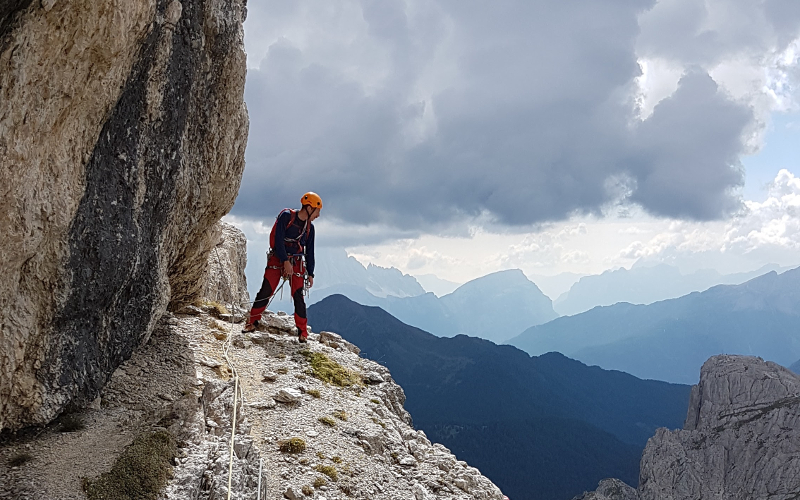Rock climbing is special in the Dolomites. The rock predominently is (no surprise) Dolomite and presents itself as huge cliffs, with cliffs of 400m being commonplace, but also 800 – 1000m faces being frequent. Indeed the longest routes are of the order of 1600m! With mountains like Civetta, Marmolada, Lagazuoi, Cinque Torre and Sass di Stria surrounding us, there is plenty to go at.
There are so many that it is not practical to list even 1% of the routes there are. Instead we will list routes which we feel are really good and worth seeking out.
Val Pettorina itself home to the Queen of the Dolomites, Marmolada with famous big wall roues like Don Quixote, the Fish, Vinatzer-Castiglioni-Messner and Schwalbenschwanz being testpieces for the modern Alpinist. But we are surrounded by fine peaks.
Spigolo Sud, Sass di Stria, IV+/V-
Comici route, Torre Piccolo di Falzarego, V-
M.Speciale, Piccolo Lagozuoi, VI-

What to expect from alpine rock routes
- The Dolomites provide a playground which is unparalleled for alpine rock climbers. There are however some caveats to this – although, on the face of it, it’s the ideal place to learn about climbing bigger routes you need to apply a greater level of caution in some respects.
- Dolomite rock is an inherently variable medium to climb on. Some is solid as a literal rock, elsewhere you’d not hang your boots from it for fear of losing them to the void. You need to learn to recognise what is good rock and what is bad.
- The routes are big and often complex. If you are used to climbing in the UK, climbing bolted routes you may be in for a rude awakening as the route-finding here can be super complex. The line of a route is often not particularly obvious and you need to learn to sniff out the way, looking for fixed gear, threads, even following polished rock. If you are expecting to be able to follow a guide move by move, forget it. You WILL go off route and when you do you need to be able to recognise it’s happened and get back on route as efficiently as possible. Remember that guidebooks are just that – a guide and there are an infinite number of different ways you can climb the route, so keep an open mind.
- In addition, the rock here can be super steep – it is not uncommon to find overhangs on grade IV pitches – there will nearly always be huge holds to pull up on, but it can be intimidating and counterintuitive.
All this said it can serve as an excellent progression to move onwards to bigger and more serious environments. Treated with the respect it demands it’s an excellent introduction to moving quickly in difficult terrain, developing the skills to make good decisions, and how to deal with suboptimal rock. And then there’s the simple fact that it can be a total blast!
When to come
The alpine rock season is mainly from June through to mid-October, but can extend through to December and start in April if you select your objectives carefully and choose your routes well. Indeed I have climbed in March in a t-shirt. Likewise, I’ve been caught in snowstorms in August. The main thing to remember is that during August you will experience much high numbers of afternoon thunderstorms so any routes should be in the bag by 3 pm at the latest unless you have very stable and cooler than normal weather.
Gear
You could write a book on this so I will address this in a blog at a later date. But in general you need:
- A Harness
- A Helmet
- Rock shoes
- Approach shoes
- Ropes – either a single rope, double ropes or twin ropes according to your preference.
- Extenders/Quickdraws
- Slings
- Trad climbing equipment – Friends and nuts
- Kevlar cords for threads
- Locking carabiners
- A light climbing pack
- Waterproof jacket
- Warm clothing
- Water and food
- Suncream!
- Toilet paper
Grading
The main grading system is the UIAA roman numeral scale. On the occasion that there is a pitch protected substantially or fully protected by bolts, they may be given a French sport climbing grade.
Printed Guidebooks
There are a huge number of guidebooks. The most reliable we have found to be the Athesa guides by Mauro Bernardi and others. They cover smaller areas very thoroughly so can be an expensive option. The Rockfax guide by James Rushforth is excellent as an overview and far better than the much older volume by Kohler. There re also the Quarto Grado guides of which I have none but I hear very good things about them and they cover more southern areas than the others.